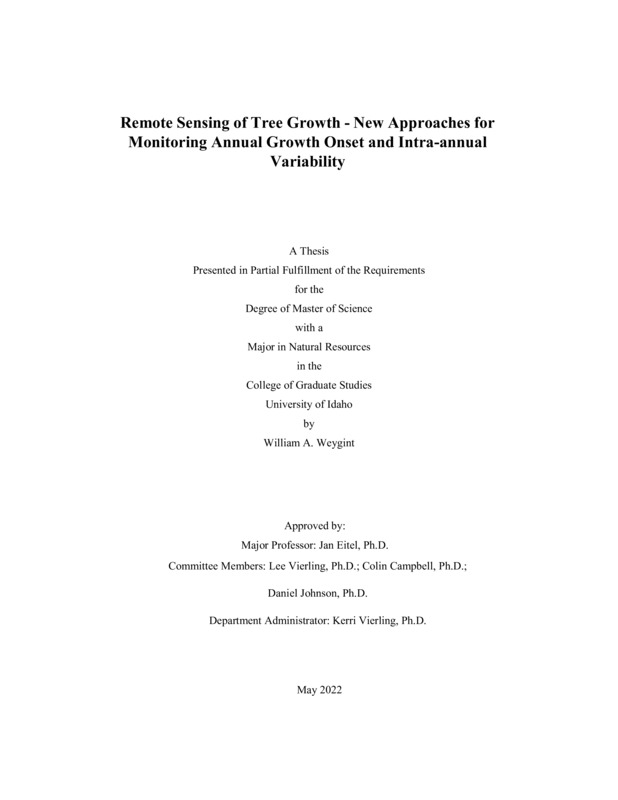Remote Sensing of Tree Growth - New Approaches for Monitoring Annual Growth Onset and Intra-annual Variability
Weygint, William A. (2022-05). Remote Sensing of Tree Growth - New Approaches for Monitoring Annual Growth Onset and Intra-annual Variability. Theses and Dissertations Collection, University of Idaho Library Digital Collections. https://www.lib.uidaho.edu/digital/etd/items/weygint_idaho_0089n_12302.html
- Title:
- Remote Sensing of Tree Growth - New Approaches for Monitoring Annual Growth Onset and Intra-annual Variability
- Author:
- Weygint, William A
- ORCID:
- 0000-0001-8516-4888
- Date:
- 2022-05
- Keywords:
- Leaf Temperatures Point Dendrometers Remote Sensing Snow Disappearance Thermography Tree growth
- Program:
- Natural Resources
- Subject Category:
- Ecology; Plant sciences; Natural resource management
- Abstract:
-
Tree growth is mechanistically linked to the global water and carbon (C) cycles and is thus a key area of research. As part of this research studies have explored linkages between remote sensing data products and tree growth, but the majority of this research has focused on tracking photosynthesis and inter-annual tree growth. Only a fewstudies have explored intra-annual stem radial growth, which provides information on long term carbon sequestration.
The following chapters explore new remote sensing-based approaches for monitor intra-annual stem radial growth in North American forests. Chapter 1 outlines some of the previous work that has used remote sensing approaches to monitor tree growth, as well as some of the potential challenges that exist.
Chapter 2 explores possible connections between remotely sensed snow disappearance date and the onset of stem radial growth in conifers at the forest-tundra ecotone (FTE) in North America. Specifically, we posed two hyphotheses: 1) that satellite based SDD estimates from the Moderate Resolution Imaging Spectroradiometer (SDDMODIS) are not significantly (p < 0.05) different than in situ measurements of SDD from soil temperature probes (SDDST), thereby suggesting that SDDMODIS is a reliable proxy for in situ SDD, and; 2) that estimates of SDD are not significantly different than the onset of tree radial growth, implying that SDDMODIS could reliably detect the start of tree wood growth at the FTE. To test our hypotheses, we used data from two field sites at the FTE - one located in Alaska (AK) and one in the Northwest Territory (NWT). SDDMODIS and SDDST were synchronous at AK, while they were asynchronous at NWT. Both SDD estimates were significantly different from tree growth onset at AK in both years but were similar in NWT. These results highlight the ecological heterogeneity of the FTE and the key knowledge gaps remaining in our understanding of environmental factors driving tree growth at this ecotone. However, our finding that remote estimates of SDD were statistically similar to tree growth onset at one field site demonstrates that remote sensing holds promise for detecting shifts in springtime tree growth phenology in response to climate change at the FTE.
Chapter 3 explores connections between branch level remotely sensed leaf temperatures (TL) and intra-annual stem radial variations (SRVs). We posed two main questions. Can we use a combination of remote sensing information and environmental variables to predict 1) tree water status, and 2) tree growth? Within Question 2, we also had two sub-questions: 2.1) Can we predict if trees are growing or not, and 2.2) Based on the results of Question 2.1, can we predict the amount of daily growth? We hypothesized that the strength of the relationship between remotely sensed TL and SRVs would vary depending on the time of day which TL was measured. We used an existing environmental monitoring network that collected near continuous SRV and TL measurements through the 2019 – 2021 growing seasons to answer these questions. Results showed that TL, along with other environmental variables, could predict SRVs reasonably well, with maximum R2 values between 0.5 – 0.75 for the best models. However, the time of day which TL was measured also changed the strength of the models, as well as the shape of the predicted model curves. These results show promise for using remotely sensed TL as a proxy for daily SRVs, though there are still key questions that remain, including how well the observed relationships scale to coarser spatial scales. This project provides a crucial first step in the development of novel remote sensing based approaches for monitoring intra-annual SRVs and outlines potential future directions.
Chapter 4 highlights some of the key findings from Chapters 2 and 3, and discusses potential avenues for future research. One highlighted area of future research includes scaling stem radial growth measurements up to a spatial and temporal resolutions equivalent to many airborne and satellite remote sensing data products. This will be a crucial area of research to continue evaluating how well remote sensing products can monitor stem radial growth in North American forests.
- Description:
- masters, M.S., Natural Resources -- University of Idaho - College of Graduate Studies, 2022-05
- Major Professor:
- Eitel, Jan U.H.
- Committee:
- Vierling, Lee A.; Campbell, Colin S.; Johnson, Daniel M.; Vierling, Kerri
- Defense Date:
- 2022-05
- Identifier:
- Weygint_idaho_0089N_12302
- Type:
- Text
- Format Original:
- Format:
- application/pdf
- Rights:
- In Copyright - Educational Use Permitted. For more information, please contact University of Idaho Library Special Collections and Archives Department at libspec@uidaho.edu.
- Standardized Rights:
- http://rightsstatements.org/vocab/InC-EDU/1.0/

